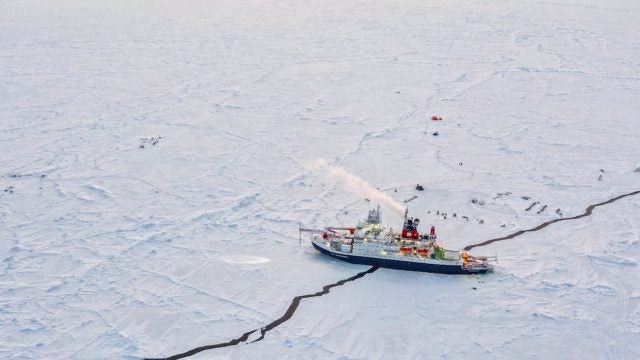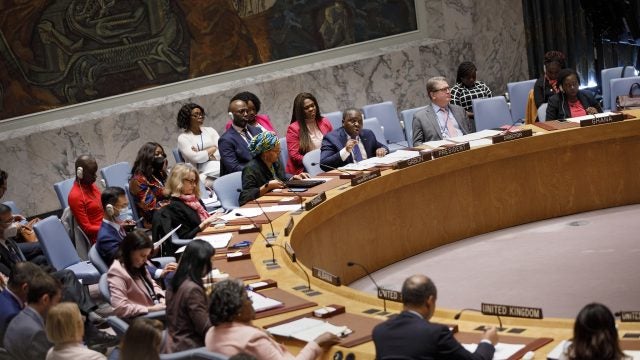
Title: The North Korea Conundrum: Pyongyang’s Strategic Calculus and Future Trajectory
North Korea’s intensified military activities must be viewed in the broader context of its domestic and foreign policy. The country’s current policies have their roots in the failed US-North Korea summit in Hanoi in February 2019, which heralded a wave of conservatism across all realms. This shift to conservatism, coupled with the North Korean leadership’s changing perception of the international order, has resulted in what could be a fundamental pivot in the country’s three-decade policy toward the United States, China, and Russia; if continued, it will have profound implications for the shape and outcome of nuclear negotiations going forward.
North Korea has catapulted back into the headlines recently with a spate of notable military activities—including several first-time tests such as that of a solid-fuel intercontinental ballistic missile (ICBM) and a nuclear-armed unmanned underwater vehicle. Such unprecedented military actions since the fall of 2022 raise questions about the country’s intentions among North Korea watchers and policymakers both at home and abroad. The country’s five-year defense development plan, articulated at the Eighth Party Congress in early 2021, could justify weapons tests, but it does not explain the unusual concentration of missile launches. Nor does the resumption of large-scale US-South Korea joint military drills alone elucidate North Korea’s unusual tit-for-tat responses.
Beyond the military aspects of Pyongyang’s nuclear and missile developments, it is just as important to examine the context in which the North Korean government is forming its decisions. Understanding how North Korea perceives the domestic and external environments lends a clearer insight into the country’s thinking, especially its longer-term strategic goals. In that vein, this piece explores the domestic and external factors behind the significant step-up in North Korea’s military activities over the past year, with special consideration given to the change in the country’s strategic calculations and the potential implications for future nuclear negotiations. The article concludes with an analysis of potential options to manage the rising risks on and around the Korean Peninsula.
Post-Hanoi Domestic and External Repositioning
North Korea’s current trajectory is consistent with its turn toward inward policies following the failure of the second US-North Korea summit in Hanoi in February 2019. Kim Jong Un’s depiction of US-North Korea relations as a “protracted confrontation” at a Party plenary meeting at the end of 2019 encapsulates the essence of the country’s post-Hanoi policy space. The summit’s failure proved to be pivotal as it brought a setback to the plans Pyongyang had likely made on the assumption that a deal would be reached in Hanoi, such as remedying the economy through sanctions relief. The fallout at the summit then became a turning point for the North Korean leadership to rethink the country’s prospects for its relations with Washington. Rethinking prospects for US-North Korea relations naturally meant a course correction on the domestic and foreign policy fronts.
In the wake of the summit’s collapse, Kim brought back to the fore a policy of “self-reliance”—a term that has traditionally been equated with closing the door to diplomacy, mainly vis-à-vis South Korea and the West. Made easier by the COVID-19 border lockdown instituted in 2020, Kim’s call for self-reliance heralded tightened control across all realms. Examples of this ranged from enacting laws penalizing the distribution and consumption of foreign cultural content, exercising greater control over foreign trade, and calls for reducing dependence on foreign technology.
Like its domestic policies, North Korea’s foreign policy shifted to a harder line following the Hanoi summit’s collapse. This is well exemplified by the resumption of missile launches in the months after the summit in 2019 and the emphasis on building its defense industry, culminating in the new five-year defense development plan in early 2021. In the following years, North Korea continued to show signs of assertiveness, after concluding that the North Korea policy of the current administration, under Joseph R. Biden Jr., was no less “hostile” than his predecessors’. In March 2022, Pyongyang fired its first ICBM since 2017, officially lifting the moratorium on longer-range missile and nuclear testing that had been in place since April 2018. Later that year, Pyongyang enacted a new nuclear law stipulating the terms of nuclear use; in a speech, Kim noted that a “line of no retreat” had been drawn and that there would “be no longer any bargaining” over the country’s nuclear weapons—his strongest comment in public on the subject. This appeared to signal a reversal of Pyongyang’s three-decade policy of seeking normalization of relations with the United States through denuclearization.
North Korea’s recalibration of its policy on Washington has gone hand in hand with a change in its thirty-year position of nonalignment with Beijing and Moscow. It has steadily improved relations with China since the failure of the Hanoi summit, as evidenced by Xi Jinping’s rare “state visit” to Pyongyang in June 2019 and North Korea’s unusually vocal endorsement of China over the Hong Kong and Taiwan issues. North Korea’s pivot toward Russia is recent but more pronounced. Starting with implicit support for Russia in the wake of its invasion of Ukraine, a notable change in North Korea’s outlook towards Russia came in Kim’s letter to Putin in June 2022, where he mentioned “strategic and tactical cooperation” between the two countries. Traditionally before this point, this expression was reserved for China, thus signifying a shift.
Kim’s Changing Strategic Calculus
North Korea’s repositioning vis-à-vis the United States, China, and Russia seems to stem from its changing view of the global order, specifically the US’s perceived role in future nuclear negotiations and economic reform. Kim first signaled this last fall when he explicitly mentioned “the change from a unipolar world advocated by the United States into a multipolar world.” This observation, coming from Kim himself, was unusual and notable for two reasons. First, while North Korean media had discussed the multi-polarization of the global order, it was unusual for Kim himself to refer to it, reflecting the seriousness with which the country’s top leadership was taking this development. Second, Kim’s remarks followed the China-Russia joint statement adopted on February 4, 2022, which declared a friendship with “no limits” and pledged to “advance multipolarity … of international relations.” Judging from Pyongyang’s swift and decisive pivot to Russia following the adoption of this joint statement, it seems the North Korean leadership saw in the document a new global order where US leadership was waning on the world stage.
These developments could be near- to mid-term adjustments for political cover in the United Nations Security Council or economic gains. However, if they indeed reflect a more fundamental change in the North Korean leadership’s thinking, then they will have deeper implications for the country’s approach to any future nuclear negotiations. Pyongyang, which has already declared itself an “irreversible” nuclear state, will have even less motivation to work toward denuclearization if it views China and Russia as a longer-term solution to its regime security vis-à-vis the United States.
The strategic value of the United States could drop even more for Pyongyang, depending on where it stands on economic reform and how it envisions making headway with improving the economy. Historically, there has been a strong correlation between North Korea’s desire for economic reform and its efforts to improve foreign relations, namely with the United States. This reiterates Pyongyang’s belief that mended ties with the United States—which it has referred to as a “favorable external environment”—are crucial to the success of reform. Although it does not seem that North Korea has rolled back on its initial initiatives, moves toward greater centralization of the economy in recent years have been a setback to reform. Additionally, if the will for economic reform fades out of Pyongyang’s long-term strategy, or if Pyongyang somehow believes it could jump-start stagnant reform with the promising alternative of Chinese capital flow—historically successful despite UN sanctions—reliance on improved relations with the United States may decline further. This could have dire consequences for the region’s security.
Regional Implications and Way Forward
North Korea’s rapid nuclear and missile advancements have prompted shifts in the region’s security dynamics. South Korea’s nuclear debate, which remained on the fringes in the past, has gone mainstream. Japan’s recent revisions of its key security documents also mentioned North Korea as one of its three biggest threats, reflecting heightened concerns. Tensions are also building in the Taiwan Strait, giving way to speculation that a cross-Strait conflict might come to pass. Should such a conflict arise, North Korea’s positioning will be crucial. With Seoul’s unmistakable pivot to the United States and Japan and Pyongyang’s aforementioned alignment with China and Russia, the confrontational dynamic between the US-South Korea-Japan and China-Russia-North Korea seems dangerous at best.
The path forward remains murky for the foreseeable future, and options are limited. The Washington Declaration is commendable for its groundbreaking steps to further bolster US defense commitments to South Korea, such as by creating a Nuclear Consultative Group for the two allies to formulate a joint response to North Korea’s nuclear use. Yet, its heavy focus on deterrence without addressing the fundamental problem at hand, curbing North Korea’s nuclear program, is a stark reminder that the current cycle of escalation will persist. Measures taken by one side to improve security will be perceived as a threat by the other side, building on its pretext to keep bolstering defense. For instance, in reaction to the latest US-South Korea summit, Pyongyang reaffirmed that it would “bolster up its military deterrence corresponding to the grave security environment.” The Chinese and Russian Foreign Ministries also have accused the document of “jeopardized[ing]” or “destabilizing” regional security.
To reduce nuclear risk and prevent armed conflict, the two allies’ efforts toward deterrence should be coupled with endeavors to seek avenues of diplomacy with North Korea and other key stakeholders in the region. If government-level engagement is unfeasible, a track-1.5 regional dialogue could be a useful starting point. This will help stakeholders to better understand each other’s concerns and perceptions toward the regional security environment while launching a discussion on the practicable first steps toward the denuclearization of the Korean Peninsula. If the new Chinese ambassador’s recent arrival in Pyongyang is indeed a sign of a gradual reopening of North Korea’s borders, it could provide more opportunities for diplomatic engagement.
Might we expect a revival of the 2017-2018 scenario, where momentum dramatically shifted from “fire and fury” to Kim Jong Un’s debut on the world stage with the US president? North Korea will probably return to nuclear talks at some point, but not until it has achieved most, if not all, of its five-year defense development plan. When it does, the terms of negotiations will likely change significantly.
. . .
Rachel Minyoung Lee is the Regional Issues Manager and Senior Analyst at the Vienna-based Open Nuclear Network and a nonresident fellow with the Stimson Center’s 38 North Program. From 2000 to 2019, she was a North Korea collection expert and analyst at the Open Source Enterprise under the CIA.
Image Credit: Stefan Krasowski
Recommended Articles

This article explores the uncertain future of Arctic governance amid shifting global geopolitics. It argues that whether Washington and Moscow opt for confrontation or cooperation, multilateralism in the Arctic…

Twenty-five years ago, the United Nations Security Council adopted Resolution 1325, establishing a framework that underpins the Women, Peace, and Security (WPS) Agenda. The Resolution recognized both the…

When we analyze conflicts in the Middle East, we are not analyzing conflicts with isolated impacts but risks for global energy security. Recent conflicts in the Middle East have highlighted…